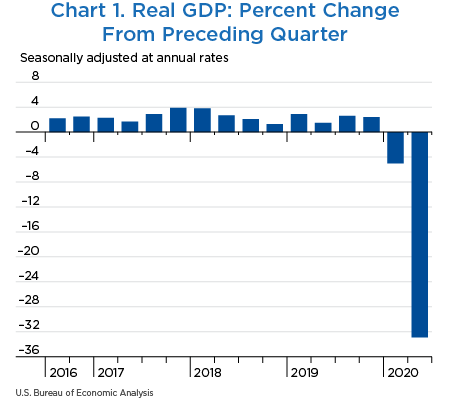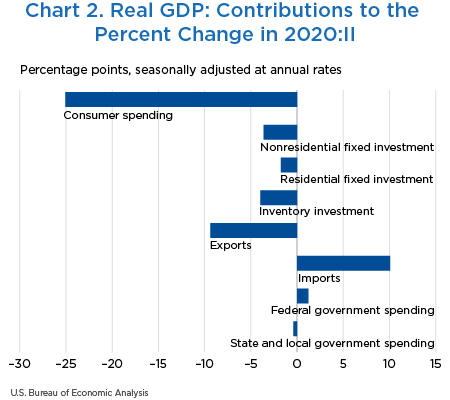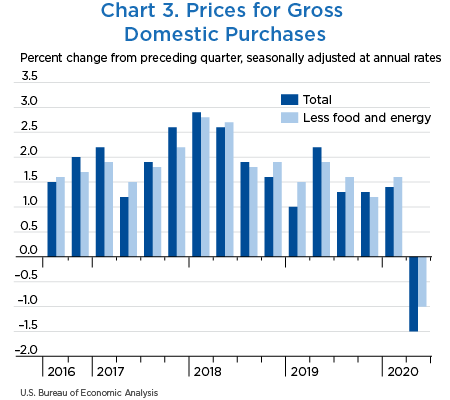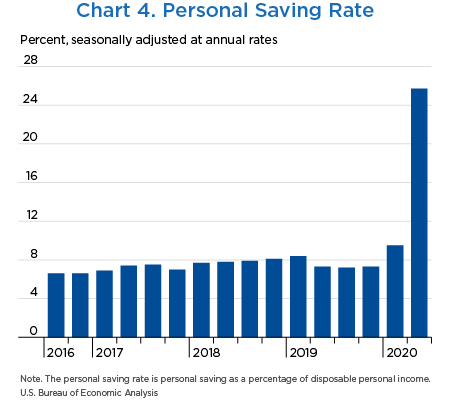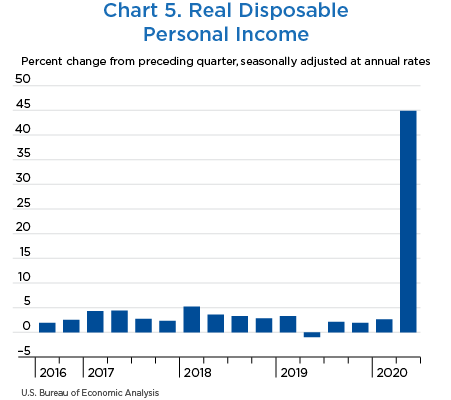GDP and the Economy
Advance Estimates for the Second Quarter of 2020
Real gross domestic product (GDP) decreased at an annual rate of 32.9 percent in the second quarter of 2020, according to the advance estimates of the National Income and Product Accounts (NIPAs) (chart 1 and table 1).1 In the first quarter of 2020, real GDP decreased 5.0 percent.
The decrease in real GDP in the second quarter reflected negative contributions from consumer spending, exports, inventory investment, nonresidential fixed investment, residential fixed investment, and state and local government spending that were partly offset by a positive contribution from federal government spending.2 Imports, which are a subtraction in the calculation of GDP, decreased (chart 2 and table 1).
With the exception of federal government spending, all GDP components contributed to the larger decrease in real GDP in the second quarter. Imports decreased more in the second quarter than in the first quarter.
- Consumer spending was the main contributor to the larger decrease in real GDP. Consumer spending decreased more in the second quarter than in the first quarter, reflecting a larger decrease in spending on services and a downturn in spending on goods.
- The main contributors to the larger decrease in services were health care (mainly hospitals and outpatient services), food services and accommodations (led by spending on purchased meals and beverages), recreation services (led by spending on membership clubs, sports centers, parks, theaters, and museums), and “other” services (mainly personal care services, which includes hairdressing salons and personal grooming establishments), as “stay-at-home” orders to protect against COVID-19 affected both the availability of and demand for services in these categories (see “Impact of the Coronavirus (COVID-19) Pandemic on the Second-Quarter 2020 GDP Estimate”).
- The main contributors to the downturn in goods were downturns in food and beverages purchased for off-premises consumption and in “other” nondurable goods (more than accounted for by pharmaceutical products) and a larger decrease in gasoline and other energy goods. Notable offsets to the downturn in goods included an upturn in motor vehicles and parts and an acceleration in spending on recreational goods and vehicles.
- Exports decreased more in the second quarter than in the first quarter, reflecting larger decreases in exports of both goods and services.
- The larger decrease in goods exports primarily reflected larger decreases in nonautomotive capital goods and automotive vehicles, engines, and parts and a downturn in industrial supplies and materials (primarily petroleum and related products).
- Larger decreases in travel services and transport services led the larger decrease in exports of services.
- Nonresidential fixed investment decreased more in the second quarter than in the first quarter; all subcomponents contributed to the slowdown.
- The larger decrease in equipment primarily reflected larger decreases in transportation equipment, “other” equipment (mainly mining and oilfield machinery, furniture and fixtures, and construction machinery excluding tractors), and industrial equipment. A notable offset to these decreases was an upturn for investment in information processing equipment (mainly computers and peripheral equipment), as many businesses shifted to virtual and remote operations in response to the COVID-19 pandemic.
- The larger decrease in structures investment was led by a large downturn in mining exploration, shafts, and wells.
- Investment in intellectual property products turned down, with all subcomponents contributing.
- The larger decrease in inventory investment was more than accounted for by a downturn in retail trade (led by motor vehicle and parts dealers) that was partly offset by an upturn in nondurable goods manufacturing (mainly reflecting an upturn in petroleum and coal product manufacturing).
- The downturn in residential investment primarily reflected a downturn in single-family structures and a downturn in brokers' commissions and other ownership transfer costs.
- State and local government spending turned down in the second quarter, primarily reflecting a larger decrease in consumption expenditures that was more than accounted for by a larger decrease in employee compensation, specifically a larger decrease in educational compensation and a downturn in noneducational compensation. For details on educational compensation, see “How does BEA measure public education services during the closings of schools and college campuses in response to the COVID-19 pandemic?”
- The larger increase in federal government spending was led by a larger increase in federal nondefense consumption expenditures, primarily for intermediate services purchased by government, which in turn reflected payments to lending institutions for administering loans provided through the Paycheck Protection Program. For additional details, see “How does the Paycheck Protection Program of 2020 impact the national income and product accounts (NIPAs)?”
- Imports decreased more in the second quarter than in the first quarter, reflecting larger decreases in imports of both goods and services.
- The larger decrease in imports of goods primarily reflected a larger decrease in imports of automotive vehicles, engines, and parts.
- The larger decrease in imports of services was led by larger decreases in both travel and transport services.
| Line | Share of current-dollar GDP (percent) | Change from preceding period (percent) | Contribution to percent change in real GDP (percentage points) | |||||||
|---|---|---|---|---|---|---|---|---|---|---|
| 2020 | 2019 | 2020 | 2019 | 2020 | ||||||
| II | III | IV | I | II | III | IV | I | II | ||
| 1 | Gross domestic product1 | 100.0 | 2.6 | 2.4 | −5.0 | −32.9 | 2.6 | 2.4 | −5.0 | −32.9 |
| 2 | Personal consumption expenditures | 67.1 | 2.7 | 1.6 | −6.9 | −34.6 | 1.83 | 1.07 | −4.75 | −25.05 |
| 3 | Goods | 22.4 | 4.2 | 0.6 | 0.1 | −11.3 | 0.87 | 0.12 | 0.03 | −2.12 |
| 4 | Durable goods | 7.6 | 6.3 | 3.1 | −12.5 | −1.4 | 0.44 | 0.22 | −0.93 | 0.04 |
| 5 | Nondurable goods | 14.8 | 3.1 | −0.7 | 7.1 | −15.9 | 0.43 | −0.10 | 0.97 | −2.16 |
| 6 | Services | 44.7 | 2.0 | 2.0 | −9.8 | −43.5 | 0.96 | 0.96 | −4.78 | −22.93 |
| 7 | Gross private domestic investment | 16.0 | 1.8 | −3.7 | −9.0 | −49.0 | 0.34 | −0.64 | −1.56 | −9.36 |
| 8 | Fixed investment | 17.6 | 2.4 | 1.0 | −1.4 | −29.9 | 0.42 | 0.17 | −0.23 | −5.38 |
| 9 | Nonresidential | 13.6 | 1.9 | −0.3 | −6.7 | −27.0 | 0.25 | −0.04 | −0.91 | −3.62 |
| 10 | Structures | 3.0 | 3.6 | −5.3 | −3.7 | −34.9 | 0.11 | −0.16 | −0.11 | −1.16 |
| 11 | Equipment | 5.4 | −1.7 | −1.7 | −15.2 | −37.7 | −0.10 | −0.10 | −0.91 | −2.13 |
| 12 | Intellectual property products | 5.2 | 5.3 | 4.6 | 2.4 | −7.2 | 0.24 | 0.21 | 0.11 | −0.33 |
| 13 | Residential | 4.0 | 4.6 | 5.8 | 19.0 | −38.7 | 0.17 | 0.22 | 0.68 | −1.76 |
| 14 | Change in private inventories | −1.7 | ...... | ...... | ...... | ...... | −0.09 | −0.82 | −1.34 | −3.98 |
| 15 | Net exports of goods and services | −2.8 | ...... | ...... | ...... | ...... | 0.04 | 1.52 | 1.13 | 0.68 |
| 16 | Exports | 9.3 | 0.8 | 3.4 | −9.5 | −64.1 | 0.10 | 0.39 | −1.12 | −9.38 |
| 17 | Goods | 5.8 | 3.1 | 2.5 | −2.7 | −67.6 | 0.23 | 0.19 | −0.20 | −6.65 |
| 18 | Services | 3.4 | −3.2 | 5.1 | −20.8 | −56.7 | −0.13 | 0.20 | −0.92 | −2.73 |
| 19 | Imports | 12.1 | 0.5 | −7.5 | −15.0 | −53.4 | −0.06 | 1.13 | 2.25 | 10.06 |
| 20 | Goods | 10.0 | 0.7 | −9.4 | −11.4 | −48.8 | −0.08 | 1.15 | 1.36 | 7.25 |
| 21 | Services | 2.1 | −0.7 | 0.9 | −28.5 | −69.7 | 0.02 | −0.03 | 0.90 | 2.81 |
| 22 | Government consumption expenditures and gross investment | 19.8 | 2.1 | 2.4 | 1.3 | 2.7 | 0.37 | 0.42 | 0.22 | 0.82 |
| 23 | Federal | 7.8 | 4.8 | 4.0 | 1.6 | 17.4 | 0.31 | 0.26 | 0.10 | 1.23 |
| 24 | National defense | 4.5 | 5.6 | 6.6 | −0.3 | 4.1 | 0.22 | 0.26 | −0.01 | 0.20 |
| 25 | Nondefense | 3.3 | 3.5 | 0.1 | 4.4 | 39.7 | 0.09 | 0.00 | 0.11 | 1.03 |
| 26 | State and local | 12.0 | 0.6 | 1.5 | 1.1 | −5.6 | 0.06 | 0.16 | 0.12 | −0.40 |
| Addenda: | ||||||||||
| 27 | Gross domestic income (GDI)2 | ...... | 0.8 | 3.3 | −2.5 | ...... | ...... | ...... | ...... | ...... |
| 28 | Average of GDP and GDI | ...... | 1.7 | 2.8 | −3.7 | ...... | ...... | ...... | ...... | ...... |
| 29 | Final sales of domestic product | 101.7 | 2.7 | 3.2 | −3.6 | −29.3 | 2.66 | 3.18 | −3.62 | −28.93 |
| 30 | Goods | 29.4 | 4.2 | 3.2 | −3.5 | −30.9 | 1.23 | 0.94 | −0.98 | −7.91 |
| 31 | Services | 61.7 | 1.8 | 2.1 | −7.6 | −34.1 | 1.12 | 1.29 | −4.82 | −22.09 |
| 32 | Structures | 8.9 | 2.6 | 1.5 | 10.3 | −30.7 | 0.22 | 0.13 | 0.85 | −2.90 |
| 33 | Motor vehicle output | 1.7 | 21.5 | −14.6 | −24.7 | −83.8 | 0.54 | −0.43 | −0.73 | −3.64 |
| 34 | GDP excluding motor vehicle output | 98.3 | 2.1 | 2.9 | −4.4 | −30.8 | 2.03 | 2.80 | −4.23 | −29.27 |
- The GDP estimates under the contribution columns are also percent changes.
- GDI is deflated by the implicit price deflator for GDP.
Prices for gross domestic purchases, goods and services purchased by U.S. residents, decreased 1.5 percent in the second quarter after increasing 1.4 percent (revised) in the first quarter (table 2 and chart 3). Downturns in the prices paid by consumers and for state and local government spending were partly offset by an acceleration in the prices paid for investment in intellectual property products.
Food prices increased 15.7 percent in the second quarter after increasing 3.2 percent in the first quarter. Prices for energy goods and services decreased 44.6 percent after decreasing 7.0 percent. Gross domestic purchases prices excluding food and energy turned down, decreasing 1.0 percent after increasing 1.6 percent.
Consumer prices excluding food and energy, a measure of the “core” rate of inflation, turned down, decreasing 1.1 percent in the second quarter after increasing 1.6 percent in the first quarter.
| Line | Change from preceding period (percent) | Contribution to percent change in gross domestic purchases prices (percentage points) | |||||||
|---|---|---|---|---|---|---|---|---|---|
| 2019 | 2020 | 2019 | 2020 | ||||||
| III | IV | I | II | III | IV | I | II | ||
| 1 | Gross domestic purchases1 | 1.3 | 1.3 | 1.4 | −1.5 | 1.3 | 1.3 | 1.4 | −1.5 |
| 2 | Personal consumption expenditures | 1.4 | 1.5 | 1.3 | −1.9 | 0.92 | 1.02 | 0.85 | −1.24 |
| 3 | Goods | −0.9 | 0.2 | −0.9 | −6.1 | −0.19 | 0.05 | −0.19 | −1.32 |
| 4 | Durable goods | −1.8 | −2.7 | −1.7 | −4.5 | −0.12 | −0.19 | −0.12 | −0.32 |
| 5 | Nondurable goods | −0.5 | 1.8 | −0.5 | −6.9 | −0.06 | 0.24 | −0.07 | −1.00 |
| 6 | Services | 2.5 | 2.1 | 2.3 | 0.2 | 1.11 | 0.97 | 1.04 | 0.08 |
| 7 | Gross private domestic investment | 1.0 | 0.2 | 1.8 | 0.6 | 0.16 | 0.03 | 0.29 | 0.10 |
| 8 | Fixed investment | 1.0 | 0.2 | 1.3 | 0.8 | 0.17 | 0.03 | 0.21 | 0.14 |
| 9 | Nonresidential | 0.4 | −0.4 | 1.0 | 0.7 | 0.06 | −0.06 | 0.12 | 0.10 |
| 10 | Structures | 2.1 | 1.5 | 1.5 | −0.9 | 0.06 | 0.04 | 0.04 | −0.03 |
| 11 | Equipment | −1.0 | −0.1 | 0.7 | −0.3 | −0.05 | −0.01 | 0.04 | −0.02 |
| 12 | Intellectual property products | 1.1 | −2.0 | 0.9 | 3.0 | 0.05 | −0.09 | 0.04 | 0.14 |
| 13 | Residential | 3.2 | 2.4 | 2.3 | 1.1 | 0.11 | 0.09 | 0.09 | 0.04 |
| 14 | Change in private inventories | ...... | ...... | ...... | ...... | −0.01 | 0.00 | 0.08 | −0.04 |
| 15 | Government consumption expenditures and gross investment | 1.0 | 1.7 | 1.8 | −2.1 | 0.18 | 0.29 | 0.31 | −0.38 |
| 16 | Federal | 0.6 | 1.3 | −0.3 | −0.7 | 0.04 | 0.08 | −0.02 | −0.05 |
| 17 | National defense | 0.8 | 1.5 | −0.1 | −2.3 | 0.03 | 0.06 | −0.01 | −0.10 |
| 18 | Nondefense | 0.2 | 1.1 | −0.5 | 1.6 | 0.01 | 0.03 | −0.01 | 0.05 |
| 19 | State and local | 1.3 | 1.9 | 3.1 | −2.9 | 0.14 | 0.20 | 0.32 | −0.33 |
| Addenda: | |||||||||
| Gross domestic purchases: | |||||||||
| 20 | Food | −0.4 | 0.9 | 3.2 | 15.7 | −0.02 | 0.04 | 0.15 | 0.77 |
| 21 | Energy goods and services | −6.2 | 7.4 | −7.0 | −44.6 | −0.17 | 0.19 | −0.19 | −1.38 |
| 22 | Excluding food and energy | 1.6 | 1.2 | 1.6 | −1.0 | 1.45 | 1.11 | 1.49 | −0.91 |
| Personal consumption expenditures: | |||||||||
| 23 | Food and beverages purchased for off-premises consumption | −0.2 | 0.8 | 3.1 | 15.4 | ...... | ...... | ...... | ...... |
| 24 | Energy goods and services | −6.5 | 7.4 | −9.8 | −45.0 | ...... | ...... | ...... | ...... |
| 25 | Excluding food and energy | 1.9 | 1.3 | 1.6 | −1.1 | ...... | ...... | ...... | ...... |
| 26 | Gross domestic product | 1.5 | 1.4 | 1.4 | −1.8 | ...... | ...... | ...... | ...... |
| 27 | Exports of goods and services | −2.3 | −1.7 | −2.5 | −17.7 | ...... | ...... | ...... | ...... |
| 28 | Imports of goods and services | −3.2 | −1.4 | −1.4 | −12.6 | ...... | ...... | ...... | ...... |
- The estimates under the contribution columns are also percent changes.
Measured in current dollars, personal income increased $1.39 trillion in the second quarter, compared with an increase of $193.4 billion (revised) in the first quarter (table 3). The increase in personal income was more than accounted for by an increase in government social benefits that was partly offset by decreases in employee compensation and proprietors’ income. The addenda to table 3 include details on the effects of selected federal pandemic response programs on personal income.
- Government social benefits increased $2.42 trillion in the second quarter after increasing $80.9 billion in the first quarter, as several provisions of federal recovery legislation took effect. Most notably, unemployment insurance and “other” government social benefits to persons increased to historic levels.
- Within unemployment insurance, the increase was primarily attributable to new and expanded unemployment insurance program benefits totaling $768.8 billion.
- Within “other” social benefits, the increase primarily reflected one-time economic impact payments to individuals totaling $1.08 trillion.
- Within compensation, the leading contributor to the decrease was private wages and salaries; government wages and salaries also decreased. For more information, see “How does BEA adjust wages and salaries to account for the effects of COVID-19?”
- The decrease in proprietors’ income reflected declines in both farm and nonfarm proprietors’ income that were partly offset by provisions of the Paycheck Protection Program, which provided small businesses and farmers with forgivable loans totaling $215.9 billion that took effect in the second quarter.
Personal current taxes decreased $148.1 billion in the second quarter after increasing $35.6 billion in the first quarter.
Disposable personal income (DPI) increased $1.53 trillion in the second quarter after increasing $157.8 billion in the first quarter. Personal outlays decreased $1.57 trillion in the second quarter after decreasing $232.5 billion in the first quarter.
The personal saving rate (chart 4)—personal saving as a percentage of DPI—was 25.7 percent in the second quarter; in the first quarter, the personal saving rate was 9.5 percent.
Real DPI (chart 5) increased 44.9 percent in the second quarter after increasing 2.6 percent in the first quarter. Current-dollar DPI increased 42.1 percent after increasing 3.9 percent.
| Line | Level | Change from preceding period | ||||||
|---|---|---|---|---|---|---|---|---|
| 2020 | 2020 | 2019 | 2020 | |||||
| I | II | III | IV | I | II | |||
| 1 | Personal income | 18,954.2 | 20,340.4 | 116.7 | 163.1 | 193.4 | 1,386.2 | |
| 2 | Compensation of employees | 11,678.0 | 10,883.1 | 46.3 | 126.9 | 113.2 | −795.0 | |
| 3 | Wages and salaries | 9,529.5 | 8,849.9 | 36.4 | 111.2 | 107.0 | −679.6 | |
| 4 | Private industries | 8,047.9 | 7,428.2 | 19.7 | 100.7 | 94.9 | −619.7 | |
| 5 | Goods-producing industries | 1,543.5 | 1,407.6 | −4.1 | 16.4 | 2.2 | −136.0 | |
| 6 | Manufacturing | 914.4 | 830.0 | −7.0 | 13.5 | −3.0 | −84.4 | |
| 7 | Services-producing industries | 6,504.4 | 6,020.6 | 23.9 | 84.3 | 92.7 | −483.8 | |
| 8 | Trade, transportation, and utilities | 1,444.6 | 1,351.3 | 5.4 | 10.7 | 17.4 | −93.3 | |
| 9 | Other services-producing industries | 5,059.8 | 4,669.3 | 18.5 | 73.6 | 75.3 | −390.5 | |
| 10 | Government | 1,481.6 | 1,421.7 | 16.7 | 10.5 | 12.1 | −59.8 | |
| 11 | Supplements to wages and salaries | 2,148.6 | 2,033.2 | 9.9 | 15.7 | 6.2 | −115.4 | |
| 12 | Proprietors' income with IVA and CCAdj | 1,706.0 | 1,481.6 | 48.5 | 20.7 | 8.3 | −224.4 | |
| 13 | Farm | 56.4 | 42.4 | 22.0 | −0.2 | −2.3 | −14.0 | |
| 14 | Nonfarm | 1,649.6 | 1,439.3 | 26.5 | 20.9 | 10.6 | −210.4 | |
| 15 | Rental income of persons with CCAdj | 802.3 | 799.4 | 3.0 | 5.9 | 6.8 | −2.9 | |
| 16 | Personal income receipts on assets | 2,984.3 | 2,902.4 | −0.1 | 10.4 | 3.9 | −81.9 | |
| 17 | Personal interest income | 1,679.7 | 1,629.4 | −0.8 | 11.7 | −13.7 | −50.3 | |
| 18 | Personal dividend income | 1,304.6 | 1,273.0 | 0.7 | −1.3 | 17.6 | −31.6 | |
| 19 | Personal current transfer receipts | 3,235.5 | 5,654.6 | 23.3 | 13.3 | 80.3 | 2,419.1 | |
| 20 | Government social benefits to persons | 3,189.6 | 5,608.8 | 23.8 | 13.9 | 80.9 | 2,419.2 | |
| 21 | Social security | 1,068.5 | 1,076.8 | 7.6 | 8.8 | 25.4 | 8.3 | |
| 22 | Medicare | 804.7 | 824.1 | 10.2 | 8.0 | 6.7 | 19.4 | |
| 23 | Medicaid | 624.1 | 674.8 | 7.3 | −2.9 | 4.7 | 50.8 | |
| 24 | Unemployment insurance | 43.4 | 1,065.5 | 0.1 | 0.3 | 15.5 | 1,022.0 | |
| 25 | Veterans' benefits | 138.6 | 142.1 | 2.1 | 2.6 | 4.1 | 3.5 | |
| 26 | Other | 510.4 | 1,825.6 | −3.5 | −2.9 | 24.4 | 1,315.2 | |
| 27 | Other current transfer receipts, from business (net) | 45.9 | 45.8 | −0.4 | −0.6 | −0.6 | −0.1 | |
| 28 | Less: Contributions for government social insurance | 1,452.0 | 1,380.7 | 4.2 | 13.9 | 19.1 | −71.3 | |
| 29 | Less: Personal current taxes | 2,256.8 | 2,108.6 | −25.3 | 24.1 | 35.6 | −148.1 | |
| 30 | Equals: Disposable personal income (DPI) | 16,697.4 | 18,231.8 | 142.1 | 139.1 | 157.8 | 1,534.4 | |
| 31 | Less: Personal outlays | 15,103.3 | 13,537.6 | 147.6 | 115.9 | −232.5 | −1,565.7 | |
| 32 | Personal consumption expenditures | 14,545.5 | 13,017.8 | 148.0 | 113.9 | −213.7 | −1,527.6 | |
| 33 | Personal interest payments1 | 352.9 | 314.4 | 0.2 | −0.3 | −11.7 | −38.6 | |
| 34 | Personal current transfer payments | 204.9 | 205.4 | −0.6 | 2.3 | −7.1 | 0.5 | |
| 35 | Equals: Personal saving | 1,594.1 | 4,694.2 | −5.5 | 23.2 | 390.4 | 3,100.1 | |
| 36 | Personal saving as a percentage of DPI | 9.5 | 25.7 | ...... | ...... | ...... | ...... | |
| Addenda: | ||||||||
| Percent change at annual rate | ||||||||
| 37 | Current-dollar DPI | ...... | ...... | 3.5 | 3.4 | 3.9 | 42.1 | |
| 38 | Real DPI, chained (2012) dollars | ...... | ...... | 2.1 | 1.9 | 2.6 | 44.9 | |
| The effects of selected federal pandemic response programs on personal income (billions of dollars) | ||||||||
| In farm proprietors' income with IVA and CCAdj: | ||||||||
| 39 | Paycheck Protecton Program loans to businesses2 | ...... | ...... | ...... | ...... | ...... | 6.5 | |
| In nonfarm proprietors' income with IVA and CCAdj: | ||||||||
| 40 | Paycheck Protecton Program loans to businesses2 | ...... | ...... | ...... | ...... | ...... | 209.4 | |
| In government social benefits to persons, Medicare: | ||||||||
| 41 | Increase in Medicare rembursement rates3 | ...... | ...... | ...... | ...... | ...... | 9.7 | |
| In government social benefits to persons, Unemployment insurance:4 | ||||||||
| 42 | Pandemic Emergency Unemployment Compensation | ...... | ...... | ...... | ...... | ...... | 7.1 | |
| 43 | Pandemic Unemployment Assistance | ...... | ...... | ...... | ...... | ...... | 122.1 | |
| 44 | Pandemic Unemployment Compensation Payments | ...... | ...... | ...... | ...... | ...... | 639.6 | |
| In government social benefits to persons, Other: | ||||||||
| 45 | Economic impact payments5 | ...... | ...... | ...... | ...... | ...... | 1,078.1 | |
| 46 | Paycheck Protecton Program loans to NPISH2 | ...... | ...... | ...... | ...... | ...... | 19.1 | |
| In personal outlays, personal interest payments: | ||||||||
| 47 | Student loan forbearance6 | ...... | ...... | ...... | ...... | −7.1 | −28.9 | |
- Consists of nonmortgage interest paid by households. Note that mortgage interest paid by households is an expense item in the calculation of rental income of persons.
- The Coronavirus Aid, Relief and Economic Security Act (CARES) provides forgivable loans to help small businesses and nonprofit institutions make payroll and cover other expenses. For more information, see “How does the Paycheck Protection Program of 2020 impact the national income and product accounts (NIPAs)?”.
- The Coronavirus Aid, Relief, and Economic Security (CARES) Act temporarily suspends a two percent reduction in reimbursements paid to Medicare service providers that went into effect in 2013. Increased reimbursement rates will be in effect from May 1, 2020 through December 31, 2020.
- The Coronavirus Aid, Relief and Economic Security Act (CARES) expanded unemployment insurance benefits provided through three programs. The Federal Pandemic Unemployment Compensation (PUC) program provides a temporary weekly supplemental payment of $600 for people receiving unemployment benefits. The Pandemic Unemployment Assistance (PUA) program provides temporary unemployment benefits to people who are not usually eligible for unemployment insurance benefits. The Pandemic Emergency Unemployment Compensation (PEUC) program provides a temporary extension of unemployment benefits for 13 weeks to people who exhausted all available regular and extended unemployment benefits. For more information, see “How will the expansion of unemployment benefits in response to the COVID-19 pandemic be recorded in the NIPAs?”.
- The Coronavirus Aid, Relief and Economic Security Act (CARES) provides $300 billion in direct support economic impact payments to individuals. For more information, see “How are the economic impact payments for individuals authorized by the CARES Act of 2020 recorded in the NIPAs?”.
- The Coronavirus Aid, Relief and Economic Security Act (CARES) provides for the temporary suspension of interest payments due on certain categories of federally held student loans. For more information, see “How does the 2020 CARES Act affect BEA's estimate of personal interest payments?”.
- CCAdj
- Capital consumption adjustment
- IVA
- Inventory valuation adjustment
- “Real” estimates are in chained (2012) dollars, and price indexes are chain-type measures. Each GDP estimate for a quarter (advance, second, and third) incorporates increasingly comprehensive and improved source data; for more information, see “The Revisions to GDP, GDI, and Their Major Components” in the January 2018 Survey of Current Business. Quarterly estimates are expressed at seasonally adjusted annual rates, which reflect a rate of activity for a quarter as if it were maintained for a year.
- In this article, “consumer spending” refers to “personal consumption expenditures,” “inventory investment” refers to “change in private inventories,” and “government spending” refers to “government consumption expenditures and gross investment.”
